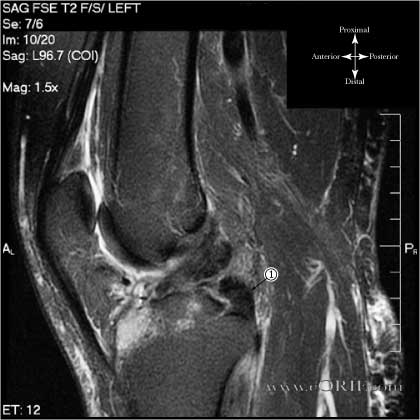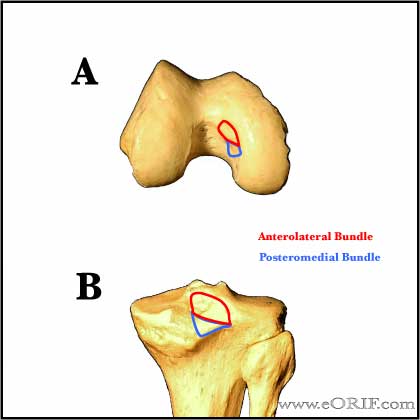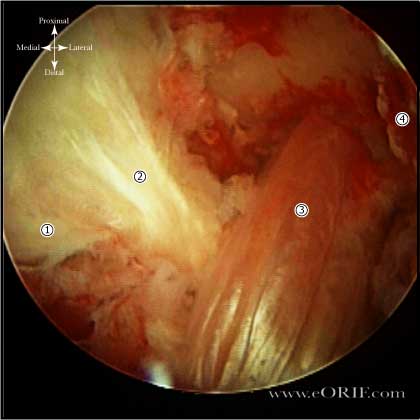|



|
synonyms: PCL reconstruction, posterior cruciate ligament reconstruction
PCL Reconstruction CPT
PCL Reconstruction Indications
- Failure of conservative treatment (functionally unstable knees)
- Combined ligamentous injury.
- Multidirectional instability.
- Acute bony avulsion injury.
PCL Reconstruction Contraindications
PCL Reconstruction Alternatives
- Non-operative treatment. (Parolie JM, AJSM 1986;14:35).
PCL Reconstruction Pre-op Planning / Special Considerations
- Single bundle reconstructions attempt to recreate the larger, stronger anterolateral bundle.
- Isolated PCL reconstruction in the setting of combined PCL / Posterolateral corner laxity will not restore knee stability and will lead to failure. (Harner CD, AJSM 2000;28:32).
- Reconstruction techniques include: tibial tunnel reconstruction and tibial inlay reconstruction.
- For tibial tunnel reconstruction the medial meniscus posterior horn insertionl lies immediately anterior to the tibial footprint of the PCL and serves as a anatomic landmark for tibial tunnel creation. (Kantaras AT, Arthroscopy 2002;18:99).
- Both techniques place the Popliteal artery at risk during reconstruction. Screws for the inlay technique are @21.1mm away fromt the popliteal artery (Miller MD, J Knee Surg 2002;15:137); Flexion during tibial tunnel drilling decreases the risk of injury (Matava MJ, Arthroscopy 2000;16:796).
PCL Reconstruction Technique
- Smith-Nephew Drill Guide Technique
- Pre-operative antibiotics, +/- regional block
- General endotracheal anesthesia
- Examination under anesthesia.
- Position: Lateral ducubitus with injured leg up (using TKA knee holder such as the Zimmer Alvarado). All bony prominences well padded.
- Prep and drape in standard sterile fashion.
- Harvest graft using paramedian anterior incision: Ensure a rectangular tibial bone block. Prepare 3.2mm hole in tibial bone block. Patellar bone block should be bullet shaped and fit through 10mm tunnel.
- Perform Knee Arthroscopy.
- Debride PCL stump.
- Prepare femoral tunnel: Place femoral tunnel guide into knee. Guide is placed into the anterosuperior PCL footprint @8mm posterior to the articular surface of the media femoral condyle. Make minimal incision at the superomedial border of the patella, splint the VMO muscle fibers and place a guide wire. Drill femoral tunnel and chamfer edges.
- Place leg on well padded Mayo stand.
- Make posteromedial hockey stick incision. Develop interval between the Semimembranosus and the medial head of the Gastrocnemius. Mobilize the medial head of the Gastrocnemiuslaterally exposing the PCL insertion on the posterior tibia, 1-1.5cm below the articular surface.
- Prepare a trough at the PCL insertion site to match the BTB graft tibial bone plug.
- Place a looped 18-gauge wire into the knee through the femoral tunnel.
- Make a small arthrotomy from the posterior incision and pull the 18-gauge wire into the posterior incision.
- Use the guide wire to pull the patellar side BTB passing sutures through the arthrotomy and out the femoral tunnel. Then use the sutures to pull the gaft into the femoral tunnel.
- Fix the tibial bone plug to the prepared trough in the posterior tibia using two 4.5mm cannulate screws with washers using standard AO technique.
- Externally rotate the knee and place on Anterior drawer force on the tibial to reproduce normal stepoff. The anterolateral bundle should be tensioned in 90 degrees of flexion. Place an interference screw from the medial femoral cortex securing the femoral side.
- Perform posterior drawer confirming restoration of stability.
- Irrigate.
- Close the posterior capsule and place a drain posteriorly.
- Close in layers.
PCL Bony Avulsion Technique
- Pre-operative antibiotics, +/- regional block
- General endotracheal anesthesia
- Examination under anesthesia.
- Prone position. All bony prominences well padded.
- Prep and drape in standard sterile fashion.
- Make posteromedial hockey stick incision. Develop interval between the Semimembranosus and the medial head of the Gastrocnemius. Mobilize the medial head of the Gastrocnemiuslaterally exposing the PCL insertion on the posterior tibia, 1-1.5cm below the articular surface.
- Bony avulsion reduced and fixed with 1-2 screws +/- washers.
- Irrigate.
- Close the posterior capsule and place a drain posteriorly.
- Close in layers.
PCL Reconstruction Complications
- Loss of stability / Graft failure:
- Osteonecrosis of the medial femoral condyle:
- Loss of fixation:
- Painful hardware:
- Infection:
- Arthritis:
- Arthrofibrosis:
- NVI
- Complex Regional Pain Syndrome:
- Hemarthrosis
PCL Reconstruction Follow-up care
- Place in hinged knee brace in full extension for four weeks
- Toe-touch weight bearing until quadriceps control is restored. Gradually progress to full-weight bearing by 6 weeks.
- Running and sport specific rehab is delayed until until 75% of quadriceps and hamstring strength have been restored, usually 6 months.
PCL Reconstruction Outcomes
- Average final follow-up IKDC subjective score was 75.1. All patients evaluated their knee as improved or greatly improved and would repeat the procedure (Cooper DE, AJSM 2004;32:346).
PCL Reconstruction Review References
- DeLee & Drez's, Orthopaedic Sports Medicine: 3e; 2009

- Noyes' Knee Disorders: Surgery, Rehabilitation, Clinical Outcomes; 2009
- Insall & Scott Surgery of the Knee: Expert Consult - Online and Print, 5e, 2011

- Harner D, Hoher J: Evaluation and treatment of posterior cruciate ligament injuries. AM J Sports Med 1998;26:471-482.
- Harner CD, Hoher J: Evaluation and treatment of posterior cruciate ligament injuries. AM J Sports Med 1998; 26:471-482.
- Clancy WG Jr., Shelbourne KD, Zoellner GB, et al: Treatment of knee joint instability secondary to rupture of the posterior cruciate ligament: Report of a new procedure. J Bone Joint Surg 1983; 65A: 310-322.
|



